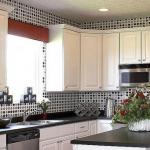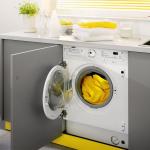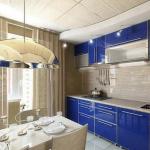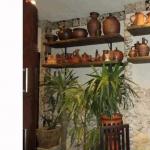How do you choose wallpaper? Coloring, drawing and color. Well, some still pay attention to the manufacturer. And this is where all the selection criteria end. Actually, why invent something if you are going to purchase several rolls for the living room, bedroom or corridor. But such a number will not work with the kitchen, here you need to select the material more carefully.
The fundamental factor in the choice of kitchen wallpaper - practicality And durability. High humidity, constant temperature fluctuations, as well as the periodic risk of soiling products impose their own nuances when buying.
What properties should wallpaper for the kitchen have
When choosing, you should carefully consider such necessary aspects as:
- light fastness;
- density;
- moisture resistance;
- vapor permeability;
- the possibility of staining;
- wash resistance.
Measure the preliminary quadrature so as not to buy too much. Rolls, of course, can be returned, but this is extra time.

So, the first factor should be close to the maximum. Considering that today's kitchens have large windows through which a huge amount of light enters, the presence of an excellent light fastness not prevent. A product that is systematically “lit” by the sun sooner or later begins to turn yellow and fade, losing its original attractiveness. The rearrangement will also become impossible, because wallpaper that has not lost its natural beauty is hidden behind cabinets and cabinets. In other words, the light fastness should be good.

From density depends on the durability of the wallpaper. The higher the indicator, the greater the “survivability of the roll. Dirt accumulates on them in smaller quantities, since there are practically no pores.
moisture resistance- the ability to withstand high humidity without any special consequences. Both external and everyone else. In addition to the fact that the kitchen itself is far from dry, the wallpaper still needs to be washed periodically. How exactly you will clean the surface depends on moisture resistance: with a slightly damp cloth, or with a thoroughly dampened sponge, on which a considerable amount of cleaning chemicals has previously been applied.

Vapor permeability is an equally important attribute. The wallpaper should dry out as soon as possible, otherwise fungus, mold and other, not entirely useful microorganisms, will appear on the walls. The microclimate of the room should also not suffer from excessive humidity.

Possibility of repeated staining typical only for wallpaper for painting. In fact, they were created for these purposes. Quality products can withstand up to 7-10 cycles of re-staining. But if for the second or third time you see a not entirely personal picture, then the wallpaper does not differ in quality.
On a note
Do not rush to immediately pay for the purchase. First, check the labels on the rolls. If the batch numbers do not match, then the tone in the rolls may differ from each other. The same applies to the position of the picture. For abstract products, this is not critical, but for composite products, yes.
Also, do not be too lazy to leave one label in case the rolls run out and the room is not completely pasted over. So it will be easier to buy the missing wallpaper.
Video: what wallpaper to choose for the kitchen
Options for materials for kitchen wallpaper
What are wallpapers? The most popular options are:
- vinyl;
- non-woven;
- fiberglass;
- silkscreen.

1. Vinyl
Vinyl is a great option, because it has such qualities as:
- density;
- resistance to moisture;
- small price.
Such wallpaper will easily last on the wall for 8-10 years, without any visible consequences for the picture. The vast majority of products are embossed embossed wallpapers with a variety of textures and colors. They can imitate fabric, mat, or plant fibers. In care, they are very unpretentious, which is important.

The composition of the roll has the following components: a paper or non-woven base, on top of which the vinyl layer is “poured”. Gluing them is a pleasure, because the roll keeps perfectly on the wall and does not deform. Moreover, they can be dyed.
When buying, pay attention to the way the vinyl is processed. The so-called "hot" embossing of hard grades of material has an increased density, but the product is quite thin and practically does not get dirty. Wallpaper easily tolerate wet cleaning, hide wall defects.

Foamed vinyl has increased relief and bumpiness, but it “breathes” better. The material even better masks all sorts of roughness and irregularities. The downside is that the surface of the wallpaper leaves much to be desired. Embossing is easily scratched, which imposes a limitation on gluing in homes where there are small and active children.
If you doubt the environmental friendliness of the product, then take a look at the range of famous manufacturers who produce products in accordance with all requirements and sanitary standards. High-quality branded vinyl has pores through which air penetrates, causing the walls to “breathe”. This has a positive effect on the evaporation of excess moisture after cleaning. And yes, it prevents mold.

But if you want to save money and think that a “deaf” roll will be more appropriate, pre-treat the wall with a primer and an antiseptic so that the fungus does not start.
As for the cost. The price of domestic products starts from 400 rubles. Relief models will cost 600 or more. The stronger and thicker the layer, the higher the cost.
2. Interlining
These products have an excellent basis. In the manufacturing process, pressed cellulose fiber is widely used. We can say that such a concept is optimal.

Interlining is much more resistant to tearing when compared with simple paper counterparts. Perfectly "breathes" and does not swell when water hits the surface. When dried, they do not dry out, and in the process of gluing they are perfectly smoothed out, leaving no air gaps.

Such wallpapers can be glued even by beginners who have no idea which side to hold the roll on. In other words, if you have no experience, then nothing bad will happen.
There is no need to apply an adhesive layer on the wallpaper. It is enough to open the wall, which is fraught with increased savings of this glue itself.

Interlining, like vinyl, perfectly tolerates moisture, but not every product can withstand intensive wet washing using brushes and other auxiliary materials with a pronounced abrasive effect. Read the description on the label carefully: it should indicate whether this wallpaper is washable or not.

Remember that under the guise of non-woven, stores can sell non-woven vinyl, exclusively non-woven products for painting, or repair rolls that are used to level the wall.

One of the main disadvantages of the above product lies in the cost. In Russia, there is not enough material for manufacturing, so it is purchased in European countries, from which the price tag rises to 800-1500 rubles per roll.
3. Fiberglass
Such wallpaper is also called fiberglass. They are extremely strong, durable and water in all its manifestations is alien to them. They are perfect for the kitchen. By and large, the texture of the material is a fabric base with fiberglass impregnation. Strength is many times higher than vinyl counterparts. It's funny that you can't do it with an ordinary table knife to trim them. It is better to stock up on a good cassette knife with sharp blades. The latter will blunt very often, which is worth remembering.

Fiberglass has a pronounced reinforcing property, while perfectly masking wall defects in the form of cracks, preventing the appearance of new ones and the spread of existing ones. They do not cause allergies and prevent the appearance of the fungus.
In the manufacturing process of the product, components such as:
- soda;
- lime;
- quartz sand;
- dolomite;
- binding additives.

If you use them for painting, you can be sure of one thing: the wallpaper will easily "survive" up to 10-15 cycles of staining with acrylic or water-dispersed counterparts. At the same time, the relief and appearance will not suffer in any way.
As for the cost. If the price tag of 2000-3000 rubles for a 25-meter roll does not bother you, they are definitely worth taking. So you will forget for the wallpaper for 10-12 years.
4. Silkscreen
What is this type of product. In fact, this is a kind of vinyl wallpaper, which is based on a paper layer. Vinyl is simply decorated with silk threads, which give the roll a very spectacular and respectable look. Silk-screen printing will be preferable for one simple reason: such wallpapers are smooth.

If you think that such a solution will lose its original gloss very quickly, then you are greatly mistaken. Silk-screen printing does not require special care, water and wet cleaning are alien to it. Products feel great in the sun without losing color.




